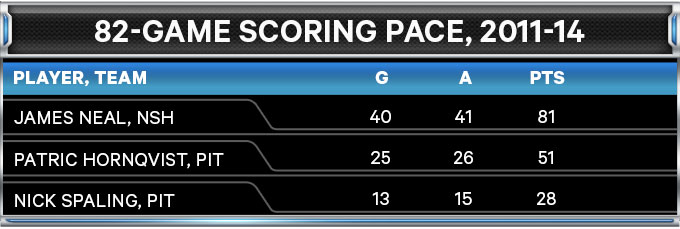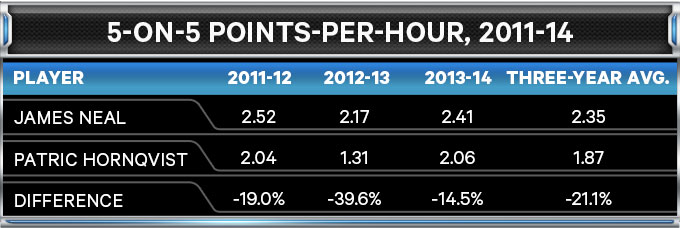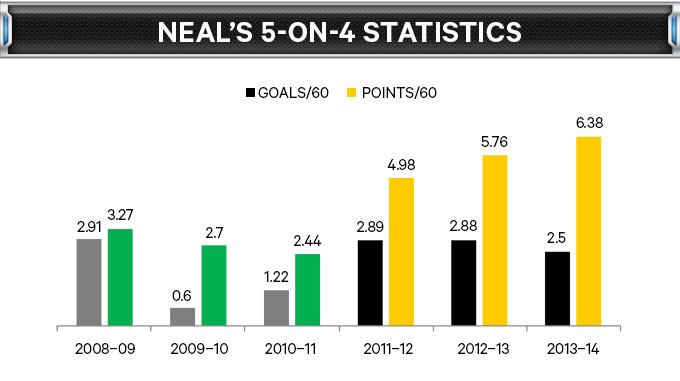This summer, the Pittsburgh Penguins took a calculated risk. They traded James Neal—a one-time 40-goal scorer who has been virtually a point-per-game player over the past three seasons—to Nashville in exchange for supporting-cast members Patric Hornqvist and Nick Spaling. The implicit gamble in the move for Pens GM Jim Rutherford was that Neal was a product of his environment and that Hornqvist would similarly flourish on a team with Sidney Crosby and Evgeni Malkin; the Preds made the simpler gamble that Neal was the best player in the trade.

As the numbers above illustrate, it’s a pretty massive risk for the Pens. Over the past three years, Neal has scored more goals and points per game than Hornqvist and Spaling combined. In a league where the team generally getting the best player wins the deal, that simple comparison understates what a massive win this deal is for the Predators if these numbers accurately reflect the reality of the situation. Nashville GM David Poile was jubilant following the deal. “Goal-scoring has been a problem for us,” he told NHL.com. “Top-line players have been a problem for us. We feel he’s a goal-scorer. That’s exactly what we were looking for.”
In contrast, Rutherford cited the versatility of his new additions, describing Hornqvist as “a complete player” and “a guy that plays with an edge” and praising Spaling’s ability to play all three positions. “They’re great team guys,” he added. “They’ll be good in our room.”
As folksy and charming as that is, high-powered NHL executives aren’t generally dumb enough to move 40-goal scorers for ‘good in the room.’ It would have been bad form for Rutherford to proclaim his smarts in selling an overvalued asset for a cheaper comparable player (and getting Spaling thrown in for good measure) and so he didn’t. But based on the numbers, there should be no doubt that he’s betting on Hornqvist to fill virtually the entire scoring void created by the loss of Neal.
It’s difficult to quantify exactly what playing with Crosby and Malkin does to a player’s scoring totals. One method is to look at those who have played with the game’s most dynamic duo and compare their points-per-hour before and after. Fortunately, HockeyAnalysis.com‘s with or without you (WOWY) function makes this relatively easy. I looked at every forward who spent significant time (minimum of four hours) with either Crosby or Malkin and significant time in another NHL city over the past seven seasons at even-strength and compared their scoring totals.

There are exceptions to the rule. Jarome Iginla, while not meeting the minimum ice-time threshold for the chart above, improved mightily after he went to Boston when compared to his time with Malkin; the two struggled to produce at even strength in their short stint together. The other notable exception is Ryan Malone, who went from splitting time with Crosby and Malkin to playing on a line with Steven Stamkos and Martin St. Louis in Tampa Bay. Nice work, if you can get it.
Still, on the whole, the performance jump for wingers alongside Malkin and Crosby is spectacular. Because we don’t usually see numbers presented in terms of points per hour, it can be hard to understand what that leap means. One way to explain it is to look at where a player with the above totals would rank league-wide. In 2013-14, a guy scoring 1.70 points per hour at even strength would have ranked around 150th in the NHL—in other words, a lower-end second-liner. A player scoring 2.13 points per hour would jump 100 spots—just below an average first-line player. At 2.27 points per hour, that same guy would be a slightly above average first-liner.
Put another way, Crosby and Malkin are pivots who can turn a grinder like Pascal Dupuis (who had topped 30 points once prior to joining the Penguins) into a scorer and a good complementary type like Chris Kunitz into an Olympian.
Neal has been somewhat famously welded to Malkin’s hip since arriving in Pittsburgh, which suggests that given average NHL linemates he’s probably in line for a drop of about one-quarter of his even-strength scoring. How does that compare to the gap between Neal and Hornqvist at five-on-five?

At even-strength, this looks like a pretty decent bet for the Penguins. Malkin tends to boost the scoring of his wingers by about 25 percent versus their output in other cities (it’s important to look at what they do in other cities because for many skilled wingers in Pittsburgh, not playing with Malkin equates to playing with Crosby and vice versa) and the gap between Hornqvist and Neal is less than that.
What about on the power play? Over the past three years, only Alex Ovechkin has more power-play goals than Neal’s 38. Hornqvist ranks a respectable 31st over that span with 19 goals. They don’t play the same role, but Pens assistant coach Rick Tocchet has said that he wanted to move to a 1-3-1 system, which would have a job open for a right-handed shooter like Hornqvist on the first unit.
There’s pretty good reason to believe that Neal’s a strong power-play option, but there’s also very good reason to think that as much as he helps the Pittsburgh power play, the Pittsburgh power play helps him more. The following chart shows Neal’s goal- and point-production per hour of power-play time over his career, with the years spent mostly in Dallas labeled in Stars colours and the years spent in Pittsburgh with Penguins colours.

In two out of three years, Neal’s goal production in Pittsburgh outpaced his point production in Dallas. The Pens have a pretty consistently reliable power play, which is what one would expect from a team with Crosby and Malkin and Kris Letang and all the rest. Neal has been a valuable part of that, but likely not an indispensable one. It would be wrong to say that Neal is a product of Malkin, just as it would be wrong to call Kunitz a product of Crosby. Both wingers are fine players; it’s just that both have had significantly better careers at both even-strength and on the power play because of who they play with. The Crosby/Malkin effect is a powerful one, and it’s the reason the Neal trade is likely a win for the Pens.

